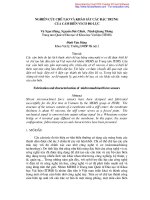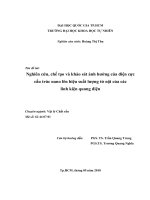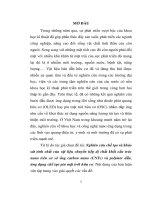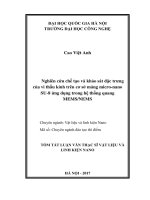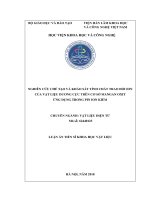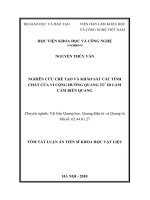Nghiên cứu chế tạo và khảo sát ảnh hưởng của một số thông số công nghệ đến đặc tính của pin nhiên liệu màng trao đổi proton tt tiếng anh
Bạn đang xem bản rút gọn của tài liệu. Xem và tải ngay bản đầy đủ của tài liệu tại đây (1.99 MB, 28 trang )
MINISTRY OF EDUCATION AND
TRAINING
VIETNAM ACADEMY OF SCIENCE
AND TECHNOLOGY
GRADUATE UNIVERSITY SCIENCE AND TECHNOLOGY
-----------------------------
GIANG HONG THAI
FABRICATION AND EVALUATION OF INFLUENCE
OF TECHNOLOGICAL PARAMETERS ON PERFORMANCE
OF PROTON EXCHANGE MEMBRANE FUEL CELL
Major: Metal Science
Code: 9.44.01.29
SUMMARY OF MATERIAL SCIENCE DOCTORAL THESIS
Hanoi – 2020
The work was completed at: Graduate University Science and Technology – Vietnam
Academy of Science and Technology
Advisors: 1. Dr. Pham Thi San
2. Prof. Dr. Vu Dinh Lam
Reviewer 1: Dr. Nguyen Van Nghia
Reviewer 2: Prof. Dr. Nguyen Huy Dan
Reviewer 3: Dr. Dang Quoc Khanh
The thesis will be protected before the doctoral dissertation thesis, meeting at the
Academy of Science and Technology - Vietnam Academy of Science and
Technology at ... hour...' date ... month ... 2020
The thesis can be found at:
- Library of the Academy of Science and Technology
- National Library of Vietnam
PREFACE
1. Urgency of thesis
Economic development lead to increases of demand for energy in the world.
Currently, energies derived from fossil energy such as oil, natural gas, coal ..., are
gradually depleting and causing environmental pollution as well as global warming.
The challenges of energy demand and sustainable development have prompted
scientists around the world to focus their research on finding new and renewable
sources of energy. Among all selectable renewable energy sources such as: solar,
wind, hydro, nuclear, geothermal, tidal, etc., the promising renewable energy source
is hydrogen fuel which is considered as a bright candidate for the future.
Proton exchange membrane fuel cells (PEMFC) using hydrogen fuel have been
the most interested in scientists around the world for three decades due to the
advantages: light weight, compact size, high power, high stability, low emission, no
noise, no pollution to the environment… Fuel cells with flexible output power should
be widely applied to electronic devices, telephones, computers, vehicles, space
stations, power stations...
Performance and applicability of fuel cells depend very strongly on the process
of manufacturing fuel cells. Therefore, research and development of fuel cell
technology are also strongly invested by scientists and companies around the world.
Companies and research facilities are extremely secretive about technology
copyrights which keeps its own technical know-how and does not spread outside.
Therefore, in order to develop fuel cell in Vietnam, we need to invest in researching
and developing our own technology and core technologies in manufacturing fuel cells
as an initial step as a prerequisite for the next development of fuel cell application.
In Vietnam, currently the study of fuel cells is almost neglected and there is
very little fundamental research on this issue. The research on fuel cells of our
country is at innitial stage, mainly researching catalytic material in the laboratory and
almost has not research in the technology of manufacturing fuel cell (stack).
From the above reasons, the group of instructors and graduate students choose
the research topic:“Fabrication and investigation of influence of technological
parameters on performance of proton exchange membrane fuel cell”.
2. Scope of thesis
1
- Study on fabrication proton exchange membrane fuel cell (PEMFC).
- Characteristics and selection of the optimal catalyst material and composition for
the catalyst layer in membrane electrodes assembly (MEA) and to evaluate influence
of manufacturing technological parameters on MEA properties and from that basis
master core technology to develop MEA manufacturing process.
- Building a model and explaining the mechanism of the process of converting
energy into electricity in MEA.
- Design, manufacture and operate a complete stack of PEMFC fuel cells with a
power of ~ 100 W.
3. Main contents of thesis
- Research, evaluate and select catalyst ink components of electrode catalyst
formation: Pt/C catalyst materials, nafion content (proton conductor)...
- Research, manufacture and evaluate MEA by the following techniques: CCS, DTM
and hot pressing process to fabricate MEA and study on influence of technological
parameters on MEA quality and optimum of MEA manufacturing process with the
best quality.
- Research, design, manufacture a complete PEMFC stack with a power of ~ 100 W
and investigate the influence of technological parameters on the properties of the
stack and give optimal operating conditions.
CHAPTER 1. INTRODUCTION
1.1. Introduction of fuel cells
A fuel cell is a device that converts chemical potential energy into electrical
energy. A Proton Exchange Membrane cell uses hydrogen gas (H2) and oxygen gas
(O2) as fuel.
1.2. Introduction of proton exchange membrane fuel cell
1.2.1. Operational principles of PEMFC
The equations for the chemical reactions at the electrodes of a PEMFC are as
follows:
Reaction on anode:
2H 2 4H 4e
Reaction oncathode:
O2 4H 4e 2H 2 O (1.2)
2
(1.1)
Total: 2H 2 O2 2H 2 O + Electricity + Heat
(1.3)
1.2.2. Structure of PEMFC
The basic structure of a proton exchange membrane fuel cell is shown in Fig. 1.4
including the components:
Fig. 1.4. Structure of PEMFC
Fig. 1.2 Principle of PEMFC
Membrane electrodes assembly (MEA)
The most important part in a PEMFC is the membrane electrode assembly
(MEA). MEA is composed of two layers of electrode catalyst material, anode and
cathode, which are symmetrically placed through a nafion film that acts as an
electrolyte medium to transport protons from the anode to the cathode.
Catalytic layers in MEA
The catalyst layer has a thickness of 5-100 µm with a porosity of about 40-70%
and is dispersed by metallic Pt catalyst particles with size of 1-10 nm.
MEA fabrication hot pressing technique
Hot pressing technique is an important step to link the components of MEA.
The three main parameters of hot pressing process including temperature, pressing
pressure and pressing time need to be optimized.
CHAPTER 2. EXPERIMENTAL AND RESEARCH METHOD
2.1. Chemicals and materials
2.2. Experimental
2.2.1. Characteristics of Pt/C electrocatalyst materials
The four types of commercial catalyst materials are Pt/C 20%wt., 30% wt. of
Fuelearth; and Pt/C 20 %wt., 40%wt. of Jonshon Mathey was selected and evaluated.
3
2.2.2. Fabrication of MEA
2.2.2.1. Fabrication of MEA by CCS method
- Creating a catalyst layer in fabrication of membrane electrodes of PEMFC by sweep
on sample with size (5x5) cm2.
Figure 2.1. Process of MEA’s fabrication by CCS method
2.2.2.2. The effect of Nafion content in catalyst ink on MEA’s properties
The catalyst layer with varying Nafion content of 20, 30, 40 and 50% of the
solid weight of catalyst ink was studied. The material used is 40% Pt/C catalyst
(HiSPEC, Johns Matthey, USA) with Pt catalyst loading on the membrane electrode
kept fixed at 0.4 mg Pt /cm2 and Nafion solution 5% (Dupont's D520).
The quality of MEAs is evaluated by the polarization curve U-I.
2.2.2.3. Fabrication of MEA by DTM method
Figure 2.2. Process of MEA’s fabrication by DTM method
2.2.3. Design and manufacture of 100W PEMFC fuel cell
2.3.Equipment and materials
2.4. Research methods
4
2.4.1. The physical characteristic methods
The surface morphology and particle size of the catalysts materials was
examined by scanning electron microscopy (SEM) and transmission electron
microscopy (TEM). Energy-dispersive X-ray spectroscopy (EDX) is used to
determine the composition of the catalyst mixture.
2.4.2. The physical electrochemical methods
Cyclic Voltammetry measurements are measured to determination of catalytic
activation and electrochemical processes on catalytic surface and catalytic
degradation. Measurements were performed in 0.5 M H2SO4 solution and the
electrochemical device used was PARSTAT2273 (EG&G –USA) with specialized
software.
Electrochemical impedance spectroscopy: frequency range is varied between
100 kHz and 10 mHz and the used AC voltage is 10 mV.
Chapter III. RESEACH, FABRICATE AND EVALUATE OF MEA
ELECTRODE
3.1. Evaluation of properties and selection of Pt/C catalyst materials used in fuel
cells (PEMFC)
3.1.1. Evaluation of electrochemical properties of Pt/C catalyst materials
The most important properties of a catalyst material in a fuel cell are the catalytic
activity and durability of the catalyst in operation environment. Therefore, the
evaluation of these properties determines the type of catalyst to be used in subsequent
studies.
3.1.1.1. Evaluation ofactivityof Pt/C catalyst materials
Fig. 3.2 shows the CV graph of carbon Vulcan XC-72 and Pt/C of FE and JM
samples with loading of 0.4 mg/cm2 Pt in 0.5 M H2SO4 solution. The ESA values
were calculated from H2 adsorption peaks in the potential range of 0-0.4 V. The ESA
area values of the catalyst samples are summarized in Table 3.1. The JM’s catalysts
have a higher ESAvalue than those of the FE’scatalysts. Thus, JM’s catalyst samples
had higher catalytic activity and reached the highest ESA value with the JM-40
catalyst samples up to about 74.91 m2/g.
5
Table 3.1. The value of ESA (electrochemical
activation area) of Pt/ C of FE and JM
Material catalyst
No
FE-20 FE-30 JM-20 JM-40
ESA
(m2/g)
56.99
62.88
64.91
74.91
Fig. 3.2. CV of Vulcan-72 and Pt/C
of FE and JM in H2SO4 0.5M
3.1.1.2. Evaluation ofdurabilityof Pt/C catalyst materials
Figure 3.4 shows a CV graph of the FE-30 catalyst sample measuring 1000
cycles in the stability test. After every 200 CV cycles, ESA values were measured
and presented in Tables 3.2 and 3.5. The JM’s catalyst samples had a lower decrease
of ESA value than the FE’s catalyst samples and the JM-40 sample reached the
lowest decrease value of 29.95%. The degradation phenomenon of Pt/C catalyst is
caused by: Firstly, Pt particles will be dissolved into ions according to the equations:
Pt → Pt2+ + 2e
(3.3)
PtO + 2H+ → Pt2+ + H2O
(3.4)
Secondly, carbon corrosion will separate a small fraction of Pt-catalyst carbon
particles. In addition, corrosion of carbon base may cause catalytic poisoning due to
the formation of CO.
Table.3.2. The change in ESA value after
1000 cycle durability test of Pt/C catalyst
samples
Catalyst samples
FE-20 FE-30 JM-20
The
change in 34.0
ESA (%)
35.7
32.3
JM-40
29.9
Fig. 3.3. The model illustrates the
processes affecting the durability of Pt/C
catalyst
6
Fig. 3.4. CV graph evaluating durability in
1000 cycles of FE-30 catalyst in 0.5M H2SO4
Fig. 3.5. The graph shows the change in
ESA value of different catalyst samples
after 1000 cycle durability test
Thus, the JM-40 catalyst exhibits best activity and durability and is selected for
use in subsequent studies.
3.1.2. Evaluation of physical properties of Pt/C catalyst materials
TEM images of the four catalysts show the common Pt particle size in the
range of 3-4 nm. Figures 3.9, 3.10; 3.11; 3.12 present TEM images and particle size
distribution graph of Pt/C catalyst samples. Compared to FE’s catalysts, the JM’s
catalysts appear to be smaller in size and have a more uniform distribution. The
results are shown in Table 3.3.
Figure 3.9. TEM image and particle size
distribution graph of FE-20 catalyst
Figure 3.10. TEM image and particle size
distribution graph of FE-30 catalyst
Table 3.3. Average size of metal particles in Pt/C catalyst samples
Catalyst samples
Average size (nm)
FE-20
FE-30
JM-20
JM-40
3.6
3.5
3.1
3.2
7
Fig. 3.11. TEM image and particle size
distribution graph of JM-20 catalyst
Hình 3.12. TEM image and particle size
distribution graph of JM-40 catalyst
Thus, the catalyst Pt/C 40% of the weight of Johnson Matthey gave the best
activity and durability and was selected as the catalyst in the next study.
3.2.Research and manufacture MEA by catalytic coating method on gas diffuse layer
3.2.1. The effect of hot pressing parameters on properties of MEA
3.2.1.1. The effect of hot pressing parameters onelectrical properties of MEA
MEA is made fromdifferent pressure values: 17, 19, 21, 24, 28 kg.cm-2, T =
130 OC and pressing time 180 s.
a. Evaluation of electrical properties of MEAs by the polarization curve U-I
Fig. 3.13 is a graph of the U-I polarization curve of MEAs fabricated at
different pressure values. With pressure values in the range of 17-21 kg.cm-2, the U-I
curves gradually move to the left corresponding to the increase of current value at the
same potential value. This indicates that the electrical properties of the MEA become
better when the pressure value is increased within the study force range. In contrast,
at higher pressure, MEA deteriorates.
Fig. 3.13. Graph of the U-I polarization curve of MEAs fabricated at different pressure
values: 17, 19, 21, 24, and 28kg.cm-2
8
Fig. 3.15 shows the maximum power density of the membrane fabricated at
different pressure values. The highest Pmax values achieved were 365 and 374
mW.cm-2 of MEAs fabricated at pressure values of 21 and 19 kg.cm-2, respectively..
Fig. 3.15. Graph of changing the maximum power density value of Pmax of MEA
fabricated at different pressure values
Thus, by surveying the effect of pressure on MEA's properties, MEAs
manufactured at pressurevalues of 19 and 21 kg.cm-2 will give the best electrical
properties.
b. Evaluation of open circuit voltage of MEA
In theory, the standard voltage of a single fuel cell would be 1.23 V. However,
in practice OCV of a single fuel cell will vary from 0.9 to 1.2 V. Fig. 3.16 is a graph
of OCV of manufactured MEA at different pressure values. On the graph it can be
seen that MEAs manufactured at higher values of pressure, the OCV decreases.
Table 3.4. Change of open circuit
voltage according to the pressure
Pressure (kg.cm-2)
Fig. 3.16. The open circuit voltage (OCV) of
MEA fabricated at different pressure values:
17, 19, 21, 24, 28 kg.cm-2
OCV
(mV)
17
19
21
24
920
955
965
960 946
c. Evaluation of electrical properties of MEAs by EIS technique
9
28
Fig. 3.17 shows EIS graph of MEAs manufactured at different pressure values.
The equivalent circuit of EIS graphs can be modeled as shown in Fig. 3.18 in which:
Rs is the total Ohm resistor of the cell; L is an inductance that characterizes the
effects created by the collector plates and all the metal components in the system. Rct
is the charge transfer resistance of the cell.
Table 3.5. The Rs and Rct values are
extrapolated from the EIS of the MEAs
fabricated at different pressure values.
Pressure(kg.cmRs
Rct
2
)
(Ω.cm2) (Ω.cm2)
Fig. 3.17. Nyquist graphs of MEAs fabricated
by the method of hot pressing at the values
17, 19, 21, 24 and 28kg.cm-2
17
0.215
5.739
19
0.241
3.015
21
0.425
18.806
24
0.611
40.233
28
0.824
76.737
Figure 3.18. Equivalent circuit model of EIS
for a PEMFC
From datas (Table 3.5) it can be seen that the resistance values of MEA are
considerably influenced by the pressure values. When the pressure value exceeds
of 24 kg.cm-2, the Rs value varies greatly, especially at the pressure of 28 kg.cm-2.
MEA was fabricated at 19 kg.cm-2 hasthe smallest Rct value which due to the
exposure of the catalyst layer to the nafion film when fabricated under this heat
press condition to achieve the best efficiency so the electrical properties can be
improved.
3.2.1.2. Effect of pressure on deformation of MEA
From the measurements of the electrical properties of MEA fabricated at
different pressures, we found that the electrical properties of MEA are best achieved
between 19-21kg.cm-2. Thus, the pressure effect on the electrical properties of the
10
MEA may be predicted to be due to the change in geometric structure of MEA.
The change in the pressure causes MEAs deformation showing the change in
thickness (the results are summarized in Table 3.6). The mechanical deformation of
the membrane electrode MEA is obsevered on figures 3.19, 3.20 and table 3.17.
Table 3.6. The change in thickness of the MEA
according to pressures
Pressure(kg.cm-2)
Thicknees
(µm)
17
19
21
24
28
671
662 663 618 614 Fig. 3.19. Typical images of MEAs fabricated
at different pressures
Table 3.7. Thickness and deformation of
nafion membrane 212 in MEA fabricated by
hot pressing method at different pressure
values
Pressure(kg.cm-2)
17
19
21
24
Fi
28
Thickness
48,3 45,7 42,1 33,7 30,8
(µm)
Change
thickness
(%)
3,2
8,9
g. 3.20. Graph of changing thickness of
MEAs at different pressure values: 17, 19,
21, 24, 28 kg.cm-2
15,4 25,5 46,8
Fig. 3.21 and Fig. 3.22 are analytical results of a typical MEA cross- section
fabricated at hot pressing conditions: 19 kg.cm-2, 130oC and 180 s. The EDX analysis
results of the catalyst layer show that the composition of this layer consists of only Pt/C
catalyst material surrounded by solid nafion ion conductors. Meanwhile, the component
results of proton exchange membrane are mainly elements C, O and F.This confirms that
the main composition of the membrane is nafion compound. It is the homogeneity of the
use of nafion in the catalyst layer and the Nafion proton exchange membrane that will
make the bond of these layers tighter and increase the properties of the membrane
electrode.
11
Fig. 3.21. EDX analysis results of the cross
section of MEA at the catalyst site
Figure 3.22. EDX analysis results of the
cross-section of MEA at the proton
exchange membrane position
From the EDX analysis results and based on some structural models of MEA, we
have built a more specific model in order to explain the processes that affect properties
of MEA. We built an additional model (Fig. 3.24) to fit the reaction process occurring in
the anode and cathode region of the MEA. Based on the proposed model we apply to
explain the mechanisms of technological process (Fig.. 3.25 to Fig. 3.28).
Fig. 3.24. The model explains the reaction
process in MEA
Fig. 3.25. Model of catalytic ink
manufacturing process
Fig. 3.26. Model of catalytic layer creation process Fig. 3.27. Model of MEA’s structure
after hot pressing
on diffuse layer
12
a) Small pressure
b. Medium pressure
c) Great pressure
Fig. 3.28. MEA structure model with different pressures
3.2.1.3. The effect of presing time and temperature on properties of MEA
From above experiment, the pressure of 19 kg.cm-2 was selected and kept fixed
in the next survey. Hot pressing temperature is chosen three values of 100oC, 130oC,
and 140oC; The pressing times are changed to 90, 120, 180, 240, and 300 s
respectively.
The influence of time and temperature on the properties of MEAs is
summarized in table 3.8 and is shown on the graph in fig. 3.31. Best results were
obtained at 19 kg.cm-2,130oC, and 180s. This is the optimal parameter of the method
of manufacturing MEA by CCS technique.
Table 3.8. The change in capacity of MEA according to temperature and pressing
time
Pressing
time
Max capacity (mW)
100oC 130oC
140oC
90 s
266
329
283
120 s
273
351
292
180 s
280
369
306
240 s
278
363
298
300 s
268
355
289
Fig. 3.32. Powercapacity depend on the time and
temperature of pressing
13
3.2.2. Effect of nafion content in catalyst layer on properties of MEA
The effect of nafion on MEA properties is carried out with the Nafion content
varying from 20, 30, 40 and 50% of the catalyst ink. U-I and P-I polarization graphs
(Fig. 3.34 and 3.35) show MEA with 40% Nafion content for best quality. Maximum
power density achieved up to 751 mW.cm-2 as shown in Table 3.9.
Table 3.9. Maximum power value at 0.4 V of MEA with different Nafion content
% Nafion content(% k.lg)
Power density,Pmax (mW.cm-2)
Fig. 3.34. The U-I polarization curve of MEAs
with different Nafion content
20
30
40
50
196
355
751
680
Fig. 3.35. The P-I polarization curve of
MEAs with different Nafion content
3.2.3. The manufacturing process of MEA by CCS method
The manufacturingprocess of MEA by CCS method has been shown as in Fig. 3.37.
14
Figure 3.37. The manufacturing process of MEA by catalytic coating method directly on the
diffusion layer
3.3. Research and manufacture MEA by decals method
MEA fabrication by decals method (DTM) has been implemented. The
properties of this MEA were evaluated and compared with MEAfabricated by CCS
method.
Fig. 3.39. SEM image of cross section of MEA
manufactured by decals (DTM)
Fig. 3.40. Polarization curves U-I and P-I of
MEAs made by decals (DTM) and CCS method
Table 3.10. Summary of power generation characteristics of MEAs manufactured by
DTM and CCS methods
OCV (V)
I
V (V)
P max (W.cm-2)
(A.cm-2)
DTM
0.983
2.26
0.4
0.905
CCS
0.95
1.92
0.4
0.768
The maximum power of MEA manufactured by DTM method is 0.995 W.cm-2
which is about 18% higher than MEA manufactured by CCS method of 0.768W.cm-2.
Thus, when using the decals (DTM) method, the electrical properties of MEA was
improved by 18%. The reason for this quality is due to the thin, uniform catalyst ink
and good bonding with the Nafion film. However, the decals method is relatively
complicated and the catalytic loss rate is quite large. Moreover, using DTM method
requires two steps hot pressing process and this can cause cracks and fractures in the
catalytic layer which lead to distortion and reduction of the quality of the Nafion film
meaning to reduce the quality and life of fuel cells.
In our country, the DTM technique is not suitable and the research of this thesis
still focuses on the traditional method of CCS and research on the operation of PEMFC.
15
Conclusion chapter III
- The catalytic Pt/C 40% of the weight of Johnson Matthey has better performance than
Pt/C commercial catalyst materials on the market and has been selected as a catalyst
for this research.
- Nafion content in the catalyst, an important factor affecting the properties of MEA,
has also been studied. The appropriate Nafion content was found to be about 40% of
the catalyst solid mass.
- A suitable technological mode for making good quality MEA has been found. It is
fabricated MEA with catalyst layer with composition of 60% Pt and 40% Nafion
covered by brush and hot pressing technique with parameters: temperature of 130 oC,
pressing time of 180 s and force pressed 19 kg.cm-2.
- A model of structure and interaction of electrochemical reactions occurring in MEA
was developed. This model has been used to explain the technological factors that
affect the quality of MEA.
Chapter IV: STUDY TO FABRICATE FUEL CELL STACK WITH POWER
OF ~ 100W
With the purpose of manufacturing a complete fuel cell stack with a power of ~
100 W. The PEMFC stack consists of 10 single cell connected in series and each
single cell has an active area of 25 cm2.
4.1. Study on fuel channel configuration on bipolar plate
In this study, three channel configurations selected were: 1 groove, 3 grooves
and 5 grooves in the folded structure designed and fabricated on bipolar plates with
size of (5 x 5) cm2 and a wide and deep of groove about 1 mm. The design drawings
were made by Autocard 2007 software. After that, the designs were transferred to
CNC mechanical machines for processing. The material used to make bipolar plateis
HK3 graphite sheet (Tokai, Japan) with dimensions of 130x1300x10 mm.
Fig. 4.2; 4.4 and 4.6 are design drawings of channel configurations consisting
of 1 groove, 3 grooves and 5 channels. Each single cell consists of a pair of bipolar
plate. Fig. 4.3; 4.5 and 4.6 are photographs of manufactured bipolar plate. The results
of U-I polarization measurements at the same operating parameters: temperature,
16
humidity, flow rate presented in Fig. 4.8 and 4.9.
Fig. 4.2. Configuration design of
bipolar platewith 1 kink groove
Fig. 4.3. Photographs of manufactured bipolar
plate with 1 kink groove
Fig. 4.4. Configuration design of bipolar Fig. 4.3. Photographs of manufactured bipolar
plate with 3 kink groove
plate with 1 kink groove
Fig. 4.6. Configuration design of
bipolar plate with 5 kink groove
Fig. 4.7. Photographs of manufactured bipolar
plate with 5 kink groove
The results of U-I and P-I polarization measurements at the same operating
parameters such as temperature, humidity, flow rate are presented in Fig. 4.8 and 4.9.
17
Fig. 4.8. The polarization curve of bipolar
plate has different channel configurations
Fig. 4.9. Power characteristics of bipolar
plates have different channel
In range of current density from 0.3 A.cm-2to 0.9 A.cm-2, 5 grooves have better
quality than grooves of 3 and 1. Because in this region, the voltage drop is almost
linear with increase of the current density in the cell. This drop is mainly affected by
the internal resistance of the battery. Because of the 5 grooves configuration for a
more uniform gas distribution, the power output is greater. When the current density
is higher than 0.9 A.cm-2, 5 and 3 grooves tends to be equal. In high current density,
the main effects are the processes of transportation and control of mass transfer of
fuel gas flow. The 5air grooves configuration has a lower pressure difference between
the inlet and outlet of the gas, so water release capacity of this configuration is
inferior to 3 air grooves and therefore may be due to inundation resulting in the
quality of 5air grooves MEA decreased and the 3air grooves MEA increased.
Because in the coupling of fuel cells, the quality of system is determined by the
lowest quality single cell. Therefore we choose the 3 air grooves configuration for
further studies.
4.2. Design and manufacture of PEMFC
4.2.1. Calculating, design choices for PEMFC
The output power of the PEMFC is calculated by the formula: P = iA.nVcell
4.2.2.Design and manufacture of components of 100 W PEMFC
With an output power requirement about 100 W, we chose a stack of 10 singlecell with active area of 25 cm2 that connect in series. The stack used the U-shaped
fuel supply model.
18
4.2.2.1. Design and manufacture of bipolar plates
From the requirements of designing and manufacturing, bipolar plates are
designed and manufactured as shown in Fig. 4.11 and 4.12.
Fig. 4.11. Design of bipolar plate
Fig. 4.12. Bipolar plates
4.2.2.2. Design and manufacture of collector plate, shell plate and gaskets
From the requirements of designing and manufacturing, collector plate, shell
plate and gaskets are designed and manufactured as shown in Fig. 4.13, 4.14, 4.15
and 4.16.
Fig. 4.15. Design of shell plate
Fig. 4.13. Design of collector plate
Fig. 4.17. Picture of gaskets
Fig. 4.14. Collector plates
Fig. 4.16. Design of shell plate
19
4.3. Effect of operating conditions on properties of PEMFC
4.3.1. Calculate and design the fuel gas distribution system
When the fuel cell is operating, it will generate a current value based on a
certain amount of fuel consumed. The relationship between the generated current and
the fuel mass is calculated based on Faraday's law. This equation is used to calculate
the amount of oxygen and hydrogen needed to use in PEMFC as below.
Oxygen flow rate is
(mO2 )
P.M O 2
4Vc .F
Hydrogen flow rate is
(mH 2 )
P.M H 2
2Vc .F
4.3.2. Effect of fuel gas flow to the characteristics of PEMFC
In fact, the fuel gas often was fed in larger than amounts of fuel consumption in
fuel cell according to theoretical calculations. Therefore, the concept of the used fuel
coefficient S is given out by Vin (the fuel input speed) divided Vlt(the fuel
consumption rate according to theory).
Table 4.3. Values of hydrogen and oxygen gas flow were investigated
Cell
(cm2)
P
(W)
25
10
Hydrogen flow rate (mL.min-1)
S= 1 S=1.2
83
100
Oxygen flow rate (mL.min-1)
S=1.5
S= 2
S = 1 S=1.2
125
167
125
150
S=1.5
S= 2
187
250
Fig. 4.18 is a graph of the U-I polarization curve of a single cell with different
levels of hydrogen gas supply. With the change in hydrogen gas fed to the PEMFC,
we can see that the values of hydrogen fuel factor of 1.5 and 2 can be selected as
appropriate values for cell works better from an air supply standpoint. The
polarization curve of the single cell corresponding to the change in oxygen flow rate
is shown in Fig. 4.19. The value of oxygen flow rate corresponding to s = 2 gives the
best characteristic. Thus, we determined the most suitable oxygen and hydrogen flow
rate to provide a single cell with an effective area of 25 cm2 as hydrogen gas with a
flow of 125 sccm, fuel utilization factor fuel s = 1.5 and oxygen gas with flow rate of
250 sccm, fuel use factor s = 2.
20
Fig. 4.19. The effect of oxygen flow rate on
the efficiency of PEMFC
Fig. 4.18. The effect of hydrogen flow rate
on the efficiency of PEMFC
4.3.3. Effect of humidity on the properties of PEMFC
The electrical characteristics of MEA when operating at different humidity
levels are shown in Fig. 4.21 and 4.22. From the graphs of the polarization curves UI, and P-I, it can be seen that the power and polarization increase as the humidity of
the reaction gas increases. Relative humidity value suitable for fuel cell operation is
in the range of 80 - 100%.
Fig. 4.21. Graph of the U-I polarization
Fig. 4.22. Graph of the P-I polarization
curve of PEMFC working at different relative curve of PEMFC working at different relative
humidity of fuel gas
humidity of fuel gas
4.3.4. Effect of operating temperature
The effect of operating temperature on the performance of PEMFC is shown in Fig.
4.23.
21
Fig. 4.23. Graph of the U-I polarization
curve of fuel cells working at different
operating temperatures
Figure 4.24. Distributes the power of cell
according to its operating temperature
The operating temperature of a single fuel cell should only be maintained
between 70-75oC. This temperature range is also consistent with the optimal
temperature range shown in Fig. 4.24.
4.4. Characteristics of the complete 100 W PEMFC
After selecting the appropriate operating conditions for the PEMFC battery, a
maximum capacity fuel cell of the battery pack that achieves approximately 137 W is
shown in picture in Fig. 4.25. The specifications of the stack are shown in Table. 4.6.
Fig. 4.25. U-I characteristics and capacity
of PEMFC
Fig. 4.26. PEMFC stack includes 10 single
cells
Conclusion chapter IV
- The fuel cell with a capacity of ~ 100W have been researched, designed, manufactured,
including 10 single cell connected in series, with a single cell operating area of 25 cm2.
- The operating mode of the fuel cell such as temperature, fuel gas flow, humidity and
pressure have been surveyed and the maximum capacity of the fuel cell reaches ~ 130 W
with the gas flow supplied is: 1.5 L.min-1 hydrogen gas and 2.5 L.min-1oxygen, 100%
22
CONCLUSIONS
1. The popular Pt/C commercial catalyst materials on the market of Fuel earth and
Johnson Mathey with different contenthave been studied and evaluated on the
physical and electrochemical properties. The Pt/C 40% wt. catalyst materials
JohnsonMathey with average particle size is 3.2 nm, evenly distributed on the
surface of carbon materials and ESA electrochemical surface of 74.91 m2.g-1 was
the best and selected as materials used in research and manufacture of PEMFC.
2. Nafion content in catalyst ink, an important factor affecting the properties of MEA,
has also been studied. The optimum nafion content was found to be about 40% of
the solid mass of JonhsonMathey Pt/C catalyst.
3. The influence of technological parameters while fabricating MEA electrode by hot
pressing process such as: pressure, temperature and pressing time has been
investigated, evaluated and selected. The best MEA’ quality fabricated by hot
pressing received at pressing conditions: 130oC pressing temperature, 180 s
pressing time and 19 kg.cm-2 pressure force. An optimal process of manufacturing
MEA by catalytic coating on the gas diffusion layer (CCS) has been proposed.
4. A model of the structure and interaction of electrochemical reactions occurring in
MEA was developed. This model has been used to explain the effect of
technological factors to the quality of MEA and gave good results.
5. A stack of PEMFC with components that have been researched, designed,
manufactured, evaluated and showed the suitableconfiguration.The configuration
and components of PEMFC were manufactured and the PEMWE stack with 10
single cells in connect series using the U-type air supply model have been fully
assembled.
6. The effects of operating parameters including: fuel flow rate, fuel humidityof fuel air
and operating temperature were surveyed. At optimal operating conditions, the
PEMFC stack has reached maximum power of ~ 137 W.
23
